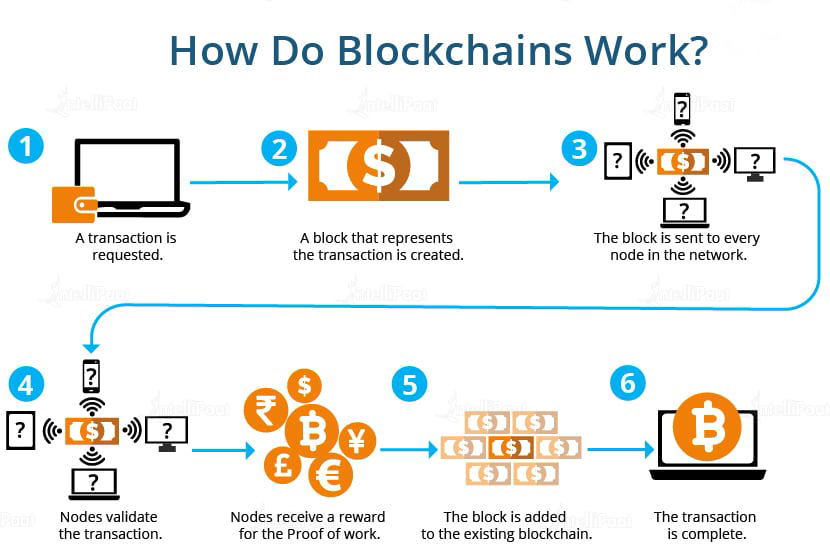What is Blockchain Technology?
Blockchain is a method of saving information in a decentralized structure that makes it impossible or difficult for the system to be changed, hacked, or manipulated. A blockchain is a distributed ledger that duplicates and distributes transactions across the network of computers participating in the blockchain.
Blockchain technology is a structure that stores transactional records, also known as the block, of the public in several databases, known as the “chain,” in a network connected through peer-to-peer nodes. Typically, this storage is referred to as a ‘digital ledger.’
Every transaction in this ledger is authorized by the digital signature of the owner, which authenticates the transaction and safeguards it from tampering. Hence, the information the digital ledger contains is highly secure.
Blockchains are best known for their crucial role in cryptocurrency systems, such as “Bitcoin“, for maintaining a secure and decentralized record of transactions. The innovation with a blockchain is that it guarantees the fidelity and security of a record of data and generates trust without the need for a trusted third party.

How it works?
When a transaction occurs, it is recorded as a “block” of data
Those transactions show the movement of an asset that can be tangible (a product) or intangible (intellectual). The data block can record the information of your choice: who, what, when, where, how much and even the condition — such as the temperature of a food shipment.
Each block is connected to the ones before and after it
These blocks form a chain of data as an asset moves from place to place or ownership changes hands. The blocks confirm the exact time and sequence of transactions, and the blocks link securely together to prevent any block from being altered or a block being inserted between two existing blocks.
Transactions are blocked together in an irreversible chain: a blockchain
Each additional block strengthens the verification of the previous block and hence the entire blockchain. This renders the blockchain tamper-evident, delivering the key strength of immutability. This removes the possibility of tampering by a malicious actor — and builds a ledger of transactions you and other network members can trust.
Benefits of Blockchain
Greater trust
With blockchain, as a member of a members-only network, you can rest assured that you are receiving accurate and timely data, and that your confidential blockchain records will be shared only with network members to whom you have specifically granted access.
Greater security
Consensus on data accuracy is required from all network members, and all validated transactions are immutable because they are recorded permanently. No one, not even a system administrator, can delete a transaction.
Efficiency
With a distributed ledger that is shared among members of a network, time-wasting record reconciliations are eliminated. And to speed transactions, a set of rules — called a smart contract — can be stored on the blockchain and executed automatically.
Bitcoin vs. Blockchain
Bitcoin is a digital currency that was first introduced in 2009 and has been the most popular and successful cryptocurrency to date. Bitcoin’s popularity is attributed to its decentralized nature, which means it doesn’t have a central authority or bank controlling its supply. This also means that transactions are anonymous, and no transaction fees are involved when using bitcoin.
Blockchain is a database of transactions that have taken place between two parties, with blocks of data containing information about each transaction being added in chronological order to the chain as it happens. The Blockchain is constantly growing as new blocks are added to it, with records becoming more difficult to change over time due to the number of blocks created after them.
Types of Blockchain
There are four different types of blockchains. They are as follows:
Private Blockchain Networks
Private blockchains operate on closed networks, and tend to work well for private businesses and organizations. Companies can use private blockchains to customize their accessibility and authorization preferences, parameters to the network, and other important security options. Only one authority manages a private blockchain network.
Public Blockchain Networks
Bitcoin and other cryptocurrencies originated from public blockchains, which also played a role in popularizing distributed ledger technology (DLT). Public blockchains also help to eliminate certain challenges and issues, such as security flaws and centralization. With DLT, data is distributed across a peer-to-peer network, rather than being stored in a single location. A consensus algorithm is used for verifying information authenticity; proof of stake (PoS) and proof of work (PoW) are two frequently used consensus methods.
Permissioned Blockchain Networks
Also sometimes known as hybrid blockchains, permissioned blockchain networks are private blockchains that allow special access for authorized individuals. Organizations typically set up these types of blockchains to get the best of both worlds, and it enables better structure when assigning who can participate in the network and in what transactions.
Consortium Blockchains
Similar to permissioned blockchains, consortium blockchains have both public and private components, except multiple organizations will manage a single consortium blockchain network. Although these types of blockchains can initially be more complex to set up, once they are running, they can offer better security. Additionally, consortium blockchains are optimal for collaboration with multiple organizations.















